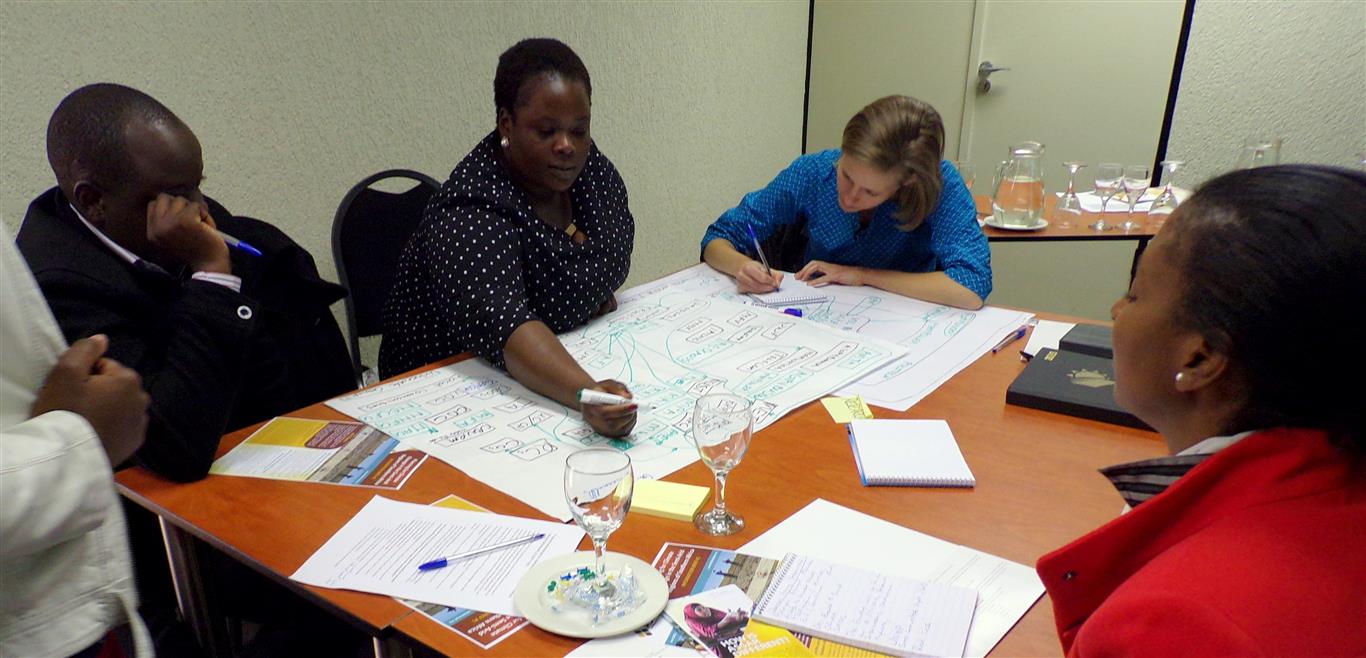How do we perceive relative levels of stakeholder influence?
Written by Salma Hegga and Lucia Scodanibbio (with thanks to Margaret Angula, Daniel Morchain, Nguza Siyambango and Dian Spear for their input)
Which key stakeholders should ASSAR target in Namibia? What are their goals? How do they interact – or not interact – with one another? How do they influence adaptation to climate change in their region and how may they contribute to strengthening ASSAR’s research process and getting ASSAR’s research findings integrated into policy and practice?
These were some of the key questions that guided a stakeholder mapping and power analysis exercise conducted by the ASSAR Southern Africa team in late July 2015. This exercise was conducted with a range of national stakeholders in Windhoek, Namibia, as a series of multiple Research into Use (RiU) and Stakeholder Engagement activities. The concrete question assessed was “Who and what influences the implementation of a climate change adaptation agenda to benefit the vulnerable rural groups (differentiated by ethnicity, gender & age) in north central Namibia?

In this half-day workshop, Eva Schiffer’s Net - Map Toolbox was used to: i) identify actors involved in a network that is critical for climate change adaptation (CCA) in north central Namibia (a semi-arid region); ii) explore network links in terms of five parameters (flow of information, knowledge or advice, provision of technical training and inputs, flow of funding, lines of authority (formal or informal) and provision of access to infrastructure and services (market, health) and; iii) identify how influential these networks are.
One of the most interesting outcomes of the workshop was to observe how different stakeholder groups perceived their own – and others’ – level of influence. For instance, while government stakeholders felt that national ministries are the most influential actors in the CCA agenda (because of their direct involvement in planning and decision-making processes) researchers felt that local governments were slightly more influential than both national and traditional authorities. In their opinion, local governments administer budgets and are responsible for implementing actions on the ground; when they lack capacity or willingness to do so, initiatives fail. Traditional authorities were also considered to be critical, as they need to approve activities and have the power to mobilise local communities and ensure their collaboration. The group of NGOs participating in the exercise, on the other hand, perceived that NGOs and research institutions (including consultancies, which often assist government to prioritise issues and undertake targeted research) were as influential as national government, partly because of their access to funding and their proximity to communities and vulnerable groups.
It was also interesting to note that despite the impacts of climate change being felt first at the local level, communities were perceived by government as having the least influence in CCA and were viewed simply as being the passive receivers of decisions taken at higher levels. This reflects a clear top-down perception of national-level government departments with respect to the CCA agenda, which in turn needs to be considered by ASSAR in its approach to RiU in Namibia. Multi-lateral organisations, in contrast, were seen as the second most influential stakeholder type in the eyes of government because of the funding they provide – once again showing a top-down trend. It was also surprising that the private sector (including state owned enterprises) was perceived by all stakeholder groups (government, researchers and NGOs to play a rather minor role. While no private sector actors were present in the workshop, it would have been interesting to see if they shared this view and how they would have ranked other stakeholders’ influence.
The process of putting knowledge into use is challenging because researchers, decision-makers and practitioners have their own experiences, perceptions and perspectives on the issue of interest. As a researcher there is a need for self-reflection and to strategize ways to ensure research findings are usable and used by the largest possible number of people. This exercise provided the opportunity for different stakeholders – as much as the ASSAR team itself – to better understand each other’s perceptions of who holds the power and thus who plays important roles in processes related to both decision-making and implementation of CCA. Hopefully, the exercise also revealed to stakeholders the benefits of expanding their usual circle of interaction. Continuous dialogue between researchers, policymakers and practitioners through stakeholder engagement activities like these, provides an opportunity for collaborative learning and increases the likelihood of research uptake.

These findings can thus have important implications for ASSAR’s stakeholder engagement and RiU strategies. While it is important to note that this process is highly subjective and dependent on the individuals present in the room (e.g. junior versus senior, representation of some ministries and not others), it nonetheless provides a good basis to verify the results in more depth, with individual stakeholders, as well as at different governance levels (e.g. national versus local). This is something that the ASSAR Southern Africa team already has on its agenda for the coming months and which will assist in building and maintaining trusting relationships with these stakeholder groups, to create a more shared vision and increased commitment and motivation for pursuing CCA.
The full summary of the exercise is available here.
The mapping exercise was part of the four days Research into Use (RiU) workshop (21st to 24th of July 2015) attended by ASSAR’s Southern Africa team: Margaret Angula, Nahas Angula, Nguza Siyambango (UNAM); Dian Spear, Salma Hegga (UCT); Hillary Masundire and Chandapiwa Molefe (UB). The workshop was facilitated by Daniel Morchain (Oxfam) to introduce the Southern African team to the concept of RiU in the ASSAR project. This event brought together 11 national stakeholders from government (Ministry of Environment and Tourism, Ministry of Industrialization, Trade and SME Development, Namibia Energy Institute), NGOs (NNF, IRDNC) and Researcher/Academic institutions (SASSCAL, DRFN & UNAM).